Aerosol Generating Dental Procedures and Its Containment Information
Aerosol-generating procedures (AGPs) are a significant risk for the transmission of COVID-19. The term first came into widespread use during the SARS pandemic from 2002 to 2004, when it primarily referred to medical treatments which generated airborne particles and were considered a major source of spreading contagious diseases.
Currently, there are six coronavirus types that cause human disease. Four of them—229E, OC43, NL63 and HKU1–often result in symptoms typical for a common cold while the other two strains—severe acute respiratory syndrome coronavirus (SARS-CoV) and Middle East respiratory syndrome coronavirus (MERS-CoV)–are more serious zoonotic diseases often linked to fatal illness.
Aerosol-generating exposure (AGE) has been introduced to take account of the varying COVID-19 transmission risk attributable to modifying factors, such as the procedure duration and the patient’s medical status. AGE also considers the risks posed by aerosols in exhaled breath and those produced during coughing and sneezing.
The Presence of Aerosol or Airborne Contaminants in Dental Procedures
Airborne contamination during dental procedures can come from a variety of sources. Among these are: dental instrumentation, salivary, and respiratory sources. Dental handpieces, ultrasonic scalers, and the air-water syringes used in common dental practice are capable of producing aerosols which are usually composed of water derived from these devices or saliva. Sometimes other liquids as well such as blood particles that can contaminate sensitive surfaces like dental chairs and other equipment.
Cleanliness is of utmost importance when it comes to dental instruments, surfaces within the operatory, and equipment- which could serve as fomites for cross-infection if not cleaned or sterilized properly.
The oral environment is naturally wet and contains a high number of microorganisms. The mouth houses 700 known pathogens, with bacteria from the respiratory tract also living in it. Dental plaque can be aerosolized during dental procedures as well to contribute to disease transmission.
According to Dentalcare.com, Dental aerosols can spread viruses as far away from the mouth.
Dentists have been shown to produce more intense aerosol and splatter with handpieces without a rubber dam or ultrasonic scalers, but any source of dental equipment is capable of sending an airborne virus up to eight feet in all directions.
Ultrasonic high-speed handpieces, three-way water/air syringes, prophy cups, and air polishing devices all have the potential to generate aerosols if they are not tightly controlled. When measured via colony-forming units that were collected onto non-specific growth media placed at locations distant from these instruments while in use ultrasonic instrumentation was suggested as having the greatest possibility of creating possible aerosol contamination.
The following are what Dentalcare.com stated as:
Dental Devices and Procedures Known to Produce Airborne Contamination
Ultrasonic Scalers – considered to be the primary source of dentistry aerosol contaminants
High-Speed Handpieces Without Rubber Dam Barrier – high aerosol production
Air Polishing – can have airborne bacterial count nearing an ultra scalers’ aerosol production
Air-Water Syringe – can have airborne bacterial count nearing an ultra scalers’ aerosol production
Tooth Preparation with Air Turbine Handpiece – can have minimal airborne contamination if a rubber dam barrier is used
Tooth Preparation with Air Abrasion – still has unknown microbial contamination but has extensive contamination with abrasive particles
Aerosol Containment Practices
Dentists who treat patients by aerosolization are at an extremely dangerous risk of getting infected themselves, as well as their dental assistants and other office staff members. Most risks occur from splatter or droplets being blown into the faces of dentists and assistants (or in the case of periodontal treatment) when they do not have a mask on them while performing procedures.
The Occupational Safety and Health Act has just released a new report on how to prepare workplaces for COVID-19. The document categorizes occupational risk as very high, high, medium, or lower risk. The dental occupations are among those that are involved with aerosol production and fall into the category of very high risk according to OSHA’s guidelines.
Dentistry is a high-risk profession, so it’s important to take every precaution possible. In dental practices where aerosol procedures will be performed, the dentists and all staff should wear PPEs and respirators or acceptable masks that are with a high-efficiency particulate arrestance (HEPA) filter; or supplied air respirator (SAR).
In light of the COVID-19 pandemic, it is essential that protocols be developed to enable minimal risk in aerosol generating dental procedures.
Reduce workplace hazards by keeping you and your take on our in-house and virtual CDC Dental Guidelines and Infection Control and Dental OSHA Training.
For our other list of in-house and online training, you may also visit the links below:
Hayes specializes in various dental handpiece repair and dental instrument sharpening and retipping. Our experienced technicians have decades of experience working with all major brands of dental handpieces including:
A-dec | Beyes | Bien Air | Denticator | Hall | Henry Schein | Impact Air | Kavo | Lares | Midwest | Morita | Nobel Biocare | Nouvag | NSK | Patterson | Schein Master | Shamrock | Star | Strauman | Stryker | W&H | Young | American Eagle | HU Friedy | Nordent | PDT




